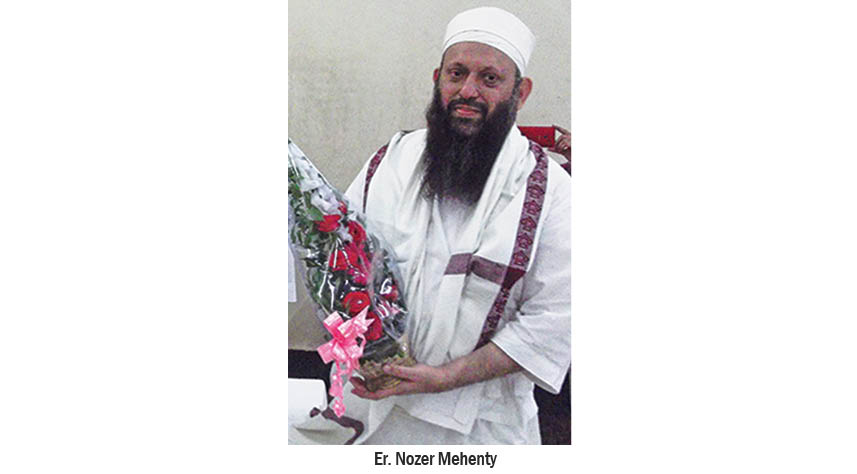.
PT: What are the Vandidad and Nirang Din rituals in Zarthosti religion?
Er. Mehenty: Vandidad- The Vandidad is divided into twenty two chapters called Paragarad, which are further divided into the following sections: The first section, comprising of the first paragarad, details the state of the earth before the advent of evil (Angra Mainyu) and the damage caused by this evil. The second section comprising the second paragarad deals with the events happening at the end of each Zara vane Daregho Khadata (the time span of thousands of years) and the two great spiritual entities given the task of saving and recreating the earth. The third and main section from paragarad three to Paragarad eighteen contains the detailed laws given by the Prophet Zarathustra to help a man fight the attack of evil. The fourth section comprising Paragarad No. 19 contains the details of the combat between Zarathustra and Angra Mainyu and the defeat of Angra Mainyu. The last section comprising Paragarad twenty to twenty two shows us the onward march of earth to its final salvation after the defeat of Angra Mainyu. Ceremony of Vandidad comprises the seventy-two chapters (Ha) of the Yezasne along with the twenty three chapters (Karda) of Visparad and the twenty two chapters (Paragarad) of Vandidad known as ‘Vandidad-Saga’
Nirangdeen- Among all the religious ceremonies extant at present, the ‘Nirangdeen ni kriya’ is the lengthiest and costliest. This ceremony is spread over eighteen days. This rite is performed for the consecration of the ‘Aab-e-Zar’, which is the urine of a complete white bull. In the beginning, that is the first nine days, a pair of pious Mobeds undergo the ‘Navraatri nu Barshnum’. On the tenth day, they take a bath. This is done to develop the spiritual powers within the two. On the 11th and 12th days, the Mobeds perform the ‘Pargarooni Kriya’. During the last six days, the ‘Gevaraa ni Kriya’ is performed each day. ‘Gevaraa’ is a term derived from the Avesta word ‘GeushUravaa’ the soul of the earth. On the 18th day, the Varasyaji along with some twenty to thirty bulls are brought, and their ‘Aab-e-Zar’ is collected in a copper or bronze vessel from the ‘Havan Geh’ onwards with the recital of the ‘Baaj’ prayers. There the Vessel is kept on a block of stone and cordoned off with a ‘Paavi’- a border made of dry pure sand from the shore. Along with the above Vessel of similar metal filled with ‘Aav’ (pure water) is placed. By now, the pair of Mobeds have become pious enough to draw towards these vessels the currents of cosmic energies that flow throughout. During the reciting of the ‘Vandidad’, the Mobeds open the lid on the vessels and glance into them. Again, they open the lid of the vessels from time to time and gently slip some ‘Sang-I-Rezaa’ (small round pebbles). After the completion of the entire ‘Kriyaa’ the vessels of the ‘Nirang’ and the ‘Aav’ are poured into two different dry and thoroughly cleaned jars. The lids are covered with a piece of clean white cloth. These ‘Nirang’ and the ‘Aav’ remain clean for any amount of time. These are used for purification processes such as the ‘Nahaan’, before the Navjote and marriage ceremony and during the ‘Barshnum’.
PT: How important are these ritual to a normal Zoroastrian?
Er. Mehenty: Benefits of Vandidad ceremony- Vandidad Ceremony helps the soul of the dear departed to break free from the earthly bonds and go to the higher plane in the spiritual world. This ceremony is also for the living to cleanse the evil from one’s self and surrounding. When this Ceremony is prayed during the Ushen Geh, there is complete peace in the surrounding with minimum vibrations of earthly activity. At such time, the ceremony prayed in the name of the dear departed helps in breaking the shell surrounding the soul, thereby releasing the soul for its onward journey. This ceremony though is meant to be prayed in the Pav Mahal as a ceremony (Kriya); people also opt for only praying the Vandidad prayers (not as a kriyaa) in their respective houses if there is constant sickness, ill will and discontent in the family. The Nirangdeen Ceremony is the very essence, the very foundation of our ‘Deen’. It is therefore very rightly and aptly named ‘Nirang-i-Deen’- The power of our Deen (Religion). The consecrated Nirang and Aav, products of the Nirangdeen ceremony are the prerequisites of various other Zoroastrian ceremonies like the ‘Barshnum and Nahn’ without which no ceremony can be performed. The ceremonies like Navjote, Navar, Martab and marriage as also certain ceremonies for the dear departed can be performed only after the officiating priest/s take the Barshnum or Nahn (Ceremonies for purifying body and soul). Immense spiritual blessings are bestowed on the soul of the person in whose memory the Nirangdeen Ceremony is performed as well as the person at whose behest (Farmayeshne) it is performed. They go on receiving the Blessings of Dadar Ahura Mazda, the Yazads and the Ameshaspands till the Nirang and Aav consecrated in the Nirangdeen ceremony are used in Barshnum ceremonies, performance of higher liturgical ceremonies for the other departed souls and various other ceremonies over a period of several years.
- Ava Yazad Parab At Thana Patell Agiary - 30 March2024
- Cowasji Patell Agiary Celebrates 244th Salgreh - 24 February2024
- પંચગનીની ચોકશી દર-એ-મેહેરે 92મી સાલગ્રેહની ઉજવણી કરી - 6 May2023
